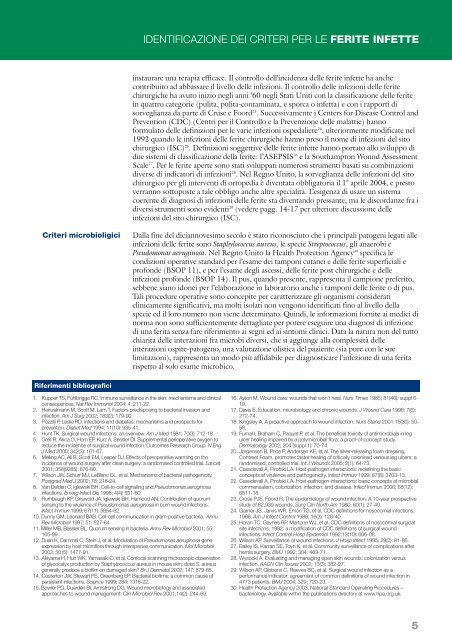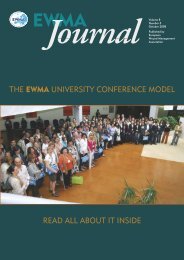Identificazione dei criteri per le ferite infette - EWMA
Identificazione dei criteri per le ferite infette - EWMA
Identificazione dei criteri per le ferite infette - EWMA
You also want an ePaper? Increase the reach of your titles
YUMPU automatically turns print PDFs into web optimized ePapers that Google loves.
Criteri microbioligici<br />
Riferimenti bibliografici<br />
1. Kup<strong>per</strong> TS, Fuhlbrigge RC. Immune surveillance in the skin: mechanisms and clinical<br />
consequences. Nat Rev Immunol 2004; 4: 211-22.<br />
2. Heinzelmann M, Scott M, Lam T. Factors predisposing to bacterial invasion and<br />
infection. Am J Surg 2002; 183(2): 179-90.<br />
3. Pozzilli P, Leslie RD. Infections and diabetes: mechanisms and prospects for<br />
prevention. Diabet Med 1994; 11(10): 935-41.<br />
4. Hunt TK. Surgical wound infections: an overview. Am J Med 1981; 70(3): 712-18.<br />
5. Greif R, Akca O, Horn EP, Kurz A, Sess<strong>le</strong>r DI. Supp<strong>le</strong>mental <strong>per</strong>io<strong>per</strong>ative oxygen to<br />
reduce the incidence of surgical wound infection. Outcomes Research Group. N Eng<br />
J Med 2000; 342(3): 161-67.<br />
6. Melling AC, Ali B, Scott EM, Lea<strong>per</strong> DJ. Effects of preo<strong>per</strong>ative warming on the<br />
incidence of wound surgery after c<strong>le</strong>an surgery: a randomised control<strong>le</strong>d trial. Lancet<br />
2001; 358(9285): 876-80.<br />
7. Wilson JW, Schurr MJ, LeBlanc CL, et al. Mechanisms of bacterial pathogenicity.<br />
Postgrad Med J 2002; 78: 216-24.<br />
8. Van Delden C, Ig<strong>le</strong>wski BH. Cell-to-cell signalling and Pseudomonas aeruginosa<br />
infections. Emerg Infect Dis 1998; 4(4): 551-60.<br />
9. Rumbaugh KP, Griswold JA, Ig<strong>le</strong>wski BH, Hamood AN. Contribution of quorum<br />
sensing to the viru<strong>le</strong>nce of Pseudomonas aeruginosa in burn wound infections.<br />
Infect Immun 1999; 67(11): 5854-62.<br />
10. Dunny GM, Leonard BAB. Cell-cell communication in gram-positive bacteria. Annu<br />
Rev Microbiol 1997; 51: 527-64.<br />
11. Mil<strong>le</strong>r MB, Bass<strong>le</strong>r BL. Quorum sensing in bacteria. Annu Rev Microbiol 2001; 55:<br />
165-99.<br />
12. Duan K, Dammel C, Stein J, et al. Modulation of Pseudomonas aeruginosa gene<br />
expression by host microflora through interspecies communication. Mol Microbiol<br />
2003; 50 (5): 1477-91.<br />
13. Akiyama H, Huh WK, Yamasaki O, et al. Confocal scanning microscopic observation<br />
of glycocalyx production by Staphylococcus aureus in mouse skin: does S. aureus<br />
generally produce a biofilm on damaged skin? Br J Dermatol 2002; 147: 879-85.<br />
14. Costerton JW, Stewart PS, Greenberg EP. Bacterial biofilms: a common cause of<br />
<strong>per</strong>sistent infections. Science 1999; 284: 1318-22.<br />
15. Bow<strong>le</strong>r PG, Duerden BI, Armstrong DG. Wound microbiology and associated<br />
approaches to wound management. Clin Microbiol Rev 2001;14(2): 244-69.<br />
IDENTIFICAZIONE DEI CRITERI PER LE FERITE INFETTE<br />
instaurare una terapia efficace. Il controllo dell'incidenza del<strong>le</strong> <strong>ferite</strong> <strong>infette</strong> ha anche<br />
contribuito ad abbassare il livello del<strong>le</strong> infezioni. Il controllo del<strong>le</strong> infezioni del<strong>le</strong> <strong>ferite</strong><br />
chirurgiche ha avuto inizio negli anni ’60 negli Stati Uniti con la classificazione del<strong>le</strong> <strong>ferite</strong><br />
in quattro categorie (pulita, pulita-contaminata, e sporca o infetta) e con i rapporti di<br />
sorveglianza da parte di Cruse e Foord 23 . Successivamente i Centers for Disease Control and<br />
Prevention (CDC) (Centri <strong>per</strong> il Controllo e la Prevenzione del<strong>le</strong> malattie) hanno<br />
formulato del<strong>le</strong> definizioni <strong>per</strong> <strong>le</strong> varie infezioni ospedaliere 24 , ulteriormente modificate nel<br />
1992 quando <strong>le</strong> infezioni del<strong>le</strong> <strong>ferite</strong> chirurgiche hanno preso il nome di infezioni del sito<br />
chirurgico (ISC) 25 . Definizioni soggettive del<strong>le</strong> <strong>ferite</strong> <strong>infette</strong> hanno portato allo sviluppo di<br />
due sistemi di classificazione della <strong>ferite</strong>: l’ASEPSIS 26 e la Southampton Wound Assessment<br />
Sca<strong>le</strong> 27 . Per <strong>le</strong> <strong>ferite</strong> a<strong>per</strong>te sono stati sviluppati numerosi strumenti basati su combinazioni<br />
diverse di indicatori di infezioni 28 . Nel Regno Unito, la sorveglianza del<strong>le</strong> infezioni del sito<br />
chirurgico <strong>per</strong> gli interventi di ortopedia è diventata obbligatoria il 1° apri<strong>le</strong> 2004, e presto<br />
verranno sottoposte a ta<strong>le</strong> obbligo anche altre specialità. L’esigenza di usare un sistema<br />
coerente di diagnosi di infezioni del<strong>le</strong> <strong>ferite</strong> sta diventando pressante, ma <strong>le</strong> discordanze fra i<br />
diversi strumenti sono evidenti 29 (vedere pagg. 14-17 <strong>per</strong> ulteriore discussione del<strong>le</strong><br />
infezioni del sito chirurgico (ISC).<br />
Dalla fine del diciannovesimo secolo è stato riconosciuto che i principali patogeni <strong>le</strong>gati al<strong>le</strong><br />
infezioni del<strong>le</strong> <strong>ferite</strong> sono Staphylococcus aureus, <strong>le</strong> specie Streptococcus, gli anaerobi e<br />
Pseudomonas aeruginosa. Nel Regno Unito la Health Protection Agency 30 specifica <strong>le</strong><br />
condizioni o<strong>per</strong>ative standard <strong>per</strong> l’esame <strong>dei</strong> tamponi cutanei e del<strong>le</strong> <strong>ferite</strong> su<strong>per</strong>ficiali e<br />
profonde (BSOP 11), e <strong>per</strong> l’esame degli ascessi, del<strong>le</strong> <strong>ferite</strong> post chirurgiche e del<strong>le</strong><br />
infezioni profonde (BSOP 14). Il pus, quando presente, rappresenta il campione preferito,<br />
sebbene siano idonei <strong>per</strong> l’elaborazione in laboratorio anche i tamponi del<strong>le</strong> <strong>ferite</strong> o di pus.<br />
Tali procedure o<strong>per</strong>ative sono concepite <strong>per</strong> caratterizzare gli organismi considerati<br />
clinicamente significativi, ma molti isolati non vengono identificati fino al livello della<br />
specie ed il loro numero non viene determinato. Quindi, <strong>le</strong> informazioni fornite ai medici di<br />
norma non sono sufficientemente dettagliate <strong>per</strong> potere eseguire una diagnosi di infezione<br />
di una ferita senza fare riferimento ai segni ed ai sintomi clinici. Data la natura non del tutto<br />
chiarita del<strong>le</strong> interazioni fra microbi diversi, che si aggiunge alla comp<strong>le</strong>ssità del<strong>le</strong><br />
interazioni ospite-patogeno, una valutazione olistica del paziente (sia pure con <strong>le</strong> sue<br />
limitazioni), rappresenta un modo più affidabi<strong>le</strong> <strong>per</strong> diagnosticare l’infezione di una ferita<br />
rispetto al solo esame microbico.<br />
16. Ayton M. Wound care: wounds that won’t heal. Nurs Times 1985; 81(46): suppl 6-<br />
19.<br />
17. Davis E. Education, microbiology and chronic wounds. J Wound Care 1998; 7(6):<br />
272-74.<br />
18. Kings<strong>le</strong>y A. A proactive approach to wound infection. Nurs Stand 2001;15(30): 50-<br />
58.<br />
19. Fumal I, Braham C, Paquet P, et al. The beneficial toxicity of antimicrobials in <strong>le</strong>g<br />
ulcer healing impaired by a polymicrobial flora: a proof-of-concept study.<br />
Dermatology 2002; 204 (suppl 1): 70-74.<br />
20. Jørgensen B, Price P, Andersen KE, et al. The silver-re<strong>le</strong>asing foam dressing,<br />
Contreet Foam, promotes faster healing of critically colonised venous <strong>le</strong>g ulcers: a<br />
randomised, control<strong>le</strong>d trial. Int J Wounds 2005; 2(1): 64-73.<br />
21. Casadevall A, Pirofski LA. Host-pathogen interactions: redefining the basic<br />
concepts of viru<strong>le</strong>nce and pathogenicity. Infect Immun 1999; 67(8): 3703-13.<br />
22. Casadevall A, Pirofski LA. Host-pathogen interactions: basic concepts of microbial<br />
commensalism, colonization, infection, and disease. Infect Immun 2000; 68(12):<br />
6511-18.<br />
23. Cruse PJE, Foord R. The epidemiology of wound infection. A 10-year prospective<br />
study of 62,939 wounds. Surg Clin North Am 1980; 60(1): 27-40.<br />
24. Garner JS, Jarvis WR, Emori TG, et al. CDC definitions for nosocomial infections,<br />
1988. Am J Infect Control 1988; 16(3): 128-40.<br />
25. Horan TC, Gaynes RP, Martone WJ, et al. CDC definitions of nosocomial surgical<br />
site infections, 1992: a modification of CDC definitions of surgical wound<br />
infections. Infect Control Hosp Epidemiol 1992;13(10): 606-08.<br />
26. Wilson AP. Surveillance of wound infections. J Hosp Infect 1995; 29(2): 81-86.<br />
27. Bai<strong>le</strong>y IS, Karran SE, Toyn K, et al. Community surveillance of complications after<br />
hernia surgery. BMJ 1992; 304: 469-71.<br />
28. Wysocki A. Evaluating and managing open skin wounds: colonization versus<br />
infection. AACN Clin Issues 2002; 13(3): 382-97.<br />
29. Wilson AP, Gibbons C, Reeves BC, et al. Surgical wound infection as a<br />
<strong>per</strong>formance indicator: agreement of common definitions of wound infection in<br />
4773 patients. BMJ 2004; 329: 720-23.<br />
30. Health Protection Agency 2003. National Standard O<strong>per</strong>ating Procedures –<br />
bacteriology. Availab<strong>le</strong> within the publications directory at www.hpa.org.uk.<br />
5
















